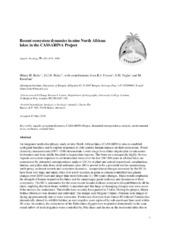Recent ecosystem dynamics in nine North African lakes in the CASSARINA Project
Peer reviewed, Journal article
Permanent lenke
https://hdl.handle.net/1956/2513Utgivelsesdato
2001Metadata
Vis full innførselSamlinger
Originalversjon
https://doi.org/10.1023/a:1011997820776Sammendrag
An integrated multi-disciplinary study of nine North African lakes (CASSARINA) aims to establish ecological baselines and to explore responses to 20th century human impacts on their ecosystems. Water chemistry measurements (1997–1998) demonstrate a wide range from dilute oligotrophic to calcareous freshwaters and from mildly brackish to hypersaline lagoons. The biota are consequently highly diverse. Aquatic ecosystem responses to environmental stress over the last 100–200 years in all nine lakes are summarised by detrended correspondence analysis (DCA) of plant and animal macrofossil, zooplankton, diatom, and pollen data from short sediment cores. DCA proved to be a powerful tool for summarising multi-proxy sediment records and ecosystem dynamics. Compositional changes measured by the DCAs have been very large and rapid, often over a few decades; as great as climate-controlled late-glacial changes over 2000 years and larger than most Holocene (11000 years) changes. These results emphasise the strength of human impact on the lakes and the surprisingly great resilience and dynamism of their ecosystems. The DCA summaries for the most recent decades indicate ecosystem disequilibrium in all the lakes, implying that their future stability is uncertain and that large or damaging changes may soon occur if the stresses are maintained. Thresholds have recently been passed in 3 lakes. During the project, Merja Bokka (Morocco) was drained and cultivated. The unique acid Megene Chitane (Tunisia) is in danger of drying up permanently due to water extraction. Freshwater diversion from Garaet El Ichkeul (Tunisia) has dramatically altered its wildlife habitat, as reed-marshes were replaced by salt-marsh and bare mud within 20 years. In contrast, the ecosystems of the Delta lakes (Egypt) have responded dramatically to the year-round inflow of fresh irrigation water controlled by Nile dams and the rise in the freshwater table due to inadequate drainage in the flat delta. The Project has demonstrated remarkably rapid responses by the lakes to environmental stresses. In particular, it highlights the threats to wetland-lake ecosystems in North Africa if uncontrolled exploitation continues.
